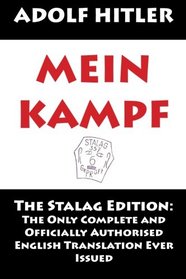Search -
Mein Kampf: The Stalag Edition
Mein Kampf The Stalag Edition
Author:
The only complete, unabridged, and officially authorised English translation ever issued by the Nazi party. Not to be confused with any other version. Translated by a now-unknown English-speaking Nazi party member & printed by the Franz Eher Verlag in Berlin in limited numbers during the years 1937?44. Most were distributed to the camp libraries... more »
Author:
The only complete, unabridged, and officially authorised English translation ever issued by the Nazi party. Not to be confused with any other version. Translated by a now-unknown English-speaking Nazi party member & printed by the Franz Eher Verlag in Berlin in limited numbers during the years 1937?44. Most were distributed to the camp libraries... more »
ISBN-13: 9781495357145
ISBN-10: 1495357147
Publication Date: 1/27/2014
Pages: 584
Edition: Second
Rating: ?
ISBN-10: 1495357147
Publication Date: 1/27/2014
Pages: 584
Edition: Second
Rating: ?
0 stars, based on 0 rating
Publisher: CreateSpace Independent Publishing Platform
Book Type: Paperback
Other Versions: Hardcover
Members Wishing: 2
Reviews: Amazon | Write a Review
Book Type: Paperback
Other Versions: Hardcover
Members Wishing: 2
Reviews: Amazon | Write a Review
Genres:




